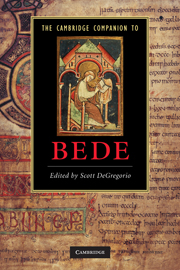Book contents
- Frontmatter
- Part I Bede’s Life and Context
- 1 Bede’s life in context
- 2 Secular and political contexts
- 3 The world of Latin learning
- 4 Church and monastery in Bede’s Northumbria
- 5 British and Irish contexts
- 6 The foundation of Bede’s Wearmouth-Jarrow
- Part II Bede's Writings
- Part III Reception and Influence
- Further reading
- Bibliography
- Index
1 - Bede’s life in context
from Part I - Bede’s Life and Context
Published online by Cambridge University Press: 28 January 2011
- Frontmatter
- Part I Bede’s Life and Context
- 1 Bede’s life in context
- 2 Secular and political contexts
- 3 The world of Latin learning
- 4 Church and monastery in Bede’s Northumbria
- 5 British and Irish contexts
- 6 The foundation of Bede’s Wearmouth-Jarrow
- Part II Bede's Writings
- Part III Reception and Influence
- Further reading
- Bibliography
- Index
Summary
In ad 731, in the fifty-ninth year of his life, Bede concluded his Ecclesiastical History of the English People with an autobiographical note in which he stated that 'it has always been my delight to learn or to teach or to write' (v. 24, p. 567). The Ecclesiastical History gives us our primary route into the early Anglo-Saxon world, yet the sources for our knowledge of the famous scholar-monk's life are sparse: his brief autobiographical note, which includes a list of his own writings; an account of his death by one of his pupils, Cuthbert; his correspondence, notably the letters he wrote to Egbert and Plegwin; his prefaces to his prose Life of Saint Cuthbert and to Book IV of his On First Samuel. These can be contextualized somewhat by other written sources, such as the anonymous Life of Ceolfrith and passages in the Anglo- Saxon Chronicle which are based upon earlier annals, and by archaeological excavations and the remains of the material culture of the age. But for deeper insight into Bede's personality and philosophy of life we are reliant upon close reading and analysis of the nuances of his own works, in various areas of study, and upon examination of those things most familiar to him: his home, the twin monastery of Wearmouth-Jarrow, its buildings, fittings and artefacts and, most importantly, the books he so loved - those he consulted and those that he helped to produce in his roles as author, editor and scribe.
- Type
- Chapter
- Information
- The Cambridge Companion to Bede , pp. 3 - 24Publisher: Cambridge University PressPrint publication year: 2010
- 3
- Cited by

